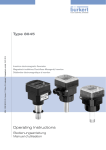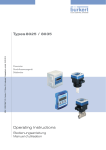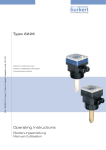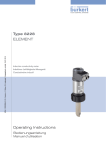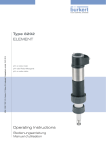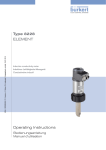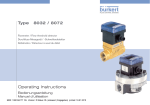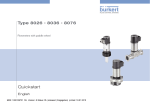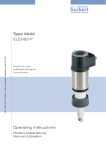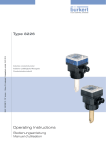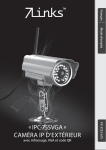Download Operating Instructions Type 8041
Transcript
Type 8041 Insertion electromagnetic flowmeter Magnetisch-induktives Durchfluss-Messgerät, Insertion Débitmètre électromagnétique à insertion Operating Instructions Bedienungsanleitung Manuel utilisateur We reserve the right to make technical changes without notice. Technische Änderungen vorbehalten. Sous réserve de modifications techniques. © Bürkert SAS, 2011 - 2013 Operating Instructions 1308/1_EU-ML_559777_Original_FR Type 8041 1. About this manual..................................................................................3 6.4. General data........................................................................................ 11 1.1. Symbols used........................................................................................3 6.5. Electrical data..................................................................................... 12 1.2. Definition of the word "device".....................................................3 6.6. Electrical connections.................................................................... 13 2. Intended use.................................................................................................4 6.7. K factors................................................................................................. 13 3. Basic safety information................................................................4 7. Quick installation............................................................................... 14 4. General information............................................................................6 8. INstallation................................................................................................ 16 4.1. Manufacturer's address and international contacts..........6 8.1. Safety instructions........................................................................... 16 4.2. Warranty conditions............................................................................6 8.2. Installation onto the pipe.............................................................. 17 4.3. Information on the Internet.............................................................6 8.2.1. Recommandations for installing the 8041 on the pipe...................................................................................17 5. Description....................................................................................................6 8.2.2. Installation into the pipe of a 8041 with a G2'' nut......20 5.1. Area of application..............................................................................6 5.2. General description............................................................................6 8.2.3. Installation into the pipe of a 8041 with a clamp connection.............................................................................21 5.2.1. Construction............................................................................ 6 8.3. Wiring....................................................................................................... 21 5.2.2. Operating principle................................................................ 6 8.3.1. Wiring the 4-20 mA output...............................................24 5.3. Description of the name plate......................................................7 8.3.2. Wiring the frequency output..............................................24 5.4. Available versions................................................................................7 8.3.3. Wiring the relay output.......................................................26 6. Technical data............................................................................................8 9. Adjustment and commissioning............................................. 27 6.1. Conditions of use.................................................................................8 9.1. Safety instructions........................................................................... 27 6.2. Conformity to standards and directives..................................8 9.2. Description of the electronic board........................................ 28 6.3. Mechanical data....................................................................................8 9.3. General diagram of the Read and English 1 Type 8041 Parameterizing modes................................................................... 30 9.4. Selecting the frequency of the main supply...................... 32 9.5. Filter selection.................................................................................... 32 9.6. Selecting the measurement range.......................................... 33 9.7. Calibrating the flow zero point.................................................. 33 9.8. Calibrating the full scale............................................................... 36 9.9. Setting the parameters of the relay output........................ 39 9.9.1. Choosing the switching way of the relay output...........40 9.9.2. Viewing and setting the low and high switching thresholds..............................................................................42 9.9.3. Viewing and setting the time delay before switching..45 10. Maintenance and troubleshooting................................. 48 10.1.Safety instructions........................................................................... 48 10.2.Cleaning the device......................................................................... 48 10.3.Cleaning the electrodes................................................................ 48 10.4.Replacing the seal on a device with G2" nut..................... 49 10.5.If you encounter problems........................................................... 49 11. Spare parts and accessories................................................ 53 12. Packaging, Transport.................................................................... 54 13. Storage........................................................................................................ 54 2 English 14. Disposal of the device.................................................................. 54 Type 8041 About this manual 1. About this manual This manual describes the entire life cycle of the device. Please keep this manual in a safe place, accessible to all users and any new owners. note Warns against material damage. • Failure to observe this warning may result in damage to the device or system. This manual contains important safety information. Indicates additional information, advice or important recommendations. Failure to comply with these instructions can lead to hazardous situations. • This manual must be read and understood. 1.1. Refers to information contained in this manual or in other documents. Symbols used danger Warns against an imminent danger. • Failure to observe this warning can result in death or in serious injury. →→Indicates a procedure to be done. 1.2. Definition of the word "device" The word "device" used within these operating instructions refers to the flowmeter type 8041. Warning Warns against a potentially dangerous situation. • Failure to observe this warning can result in serious injury or even death. attention Warns against a possible risk. • Failure to observe this warning can result in substantial or minor injuries. English 3 Type 8041 Intended use 2. Intended use Use of the device that does not comply with the instructions could present risks to people, nearby installations and the environment. • The 8041 flowmeter is intended exclusively to measure the flow rate in liquids. • This device must be protected against electromagnetic interference, ultraviolet rays and, when installed outdoors, the effects of climatic conditions. • This device must be used in compliance with the characteristics and commissioning and use conditions specified in the contractual documents and in the operating instructions. • Requirements for the safe and proper operation of the device are proper transport, storage and installation, as well as careful operation and maintenance. • Only use the device as intended. →→Observe any existing restraints when the device is exported. 3 . Bas i c sa f et y i n f o r mati o n This safety information does not take into account: • any contingencies or occurences that may arise during installation, use and maintenance of the devices. • the local safety regulations for which the operating company is responsible including the staff in charge of installation and maintenance. Danger due to high pressure in the installation. Danger due to electrical voltage. Danger due to high temperatures of the fluid. Danger due to the nature of the fluid. Various dangerous situations To avoid injury take care: • to prevent any unintentional power supply switch-on. • to ensure that installation and maintenance work are carried out by qualified, authorised personnel in possession of the appropriate tools. • to guarantee a defined or controlled restarting of the process, after a power supply interruption. 4 English Type 8041 Basic safety information note Various dangerous situations (cont'd) To avoid injury take care: • not to use the device for the measurement of gas flow rates. • not to use the device in explosive atmospheres. • not to use the device in an environment incompatible with the materials it is made of. • not to subject the device to mechanical loads (e.g. by placing objects on top of it or by using it as a step). • not to make any external or internal modifications to the device. • to use the device only if in perfect working order and in compliance with the instructions provided in these operating instructions. • to observe the general technical rules when installing and using the device. Elements / Components sensitive to electrostatic discharges • This device contains electronic components sensitive to electrostatic discharges. They may be damaged if they are touched by an electrostatically charged person or object. In the worst case scenario, these components are instantly destroyed or go out of order as soon as they are activated. • To minimise or even avoid all damage due to an electrostatic discharge, take all the precautions described in the EN 613405-1 and 5-2 norms. • Also ensure that you do not touch any of the live electrical components. note The device may be damaged by the fluid in contact with. • Systematically check the chemical compatibility of the component materials of the device and the fluids likely to come into contact with it (for example: alcohols, strong or concentrated acids, aldehydes, alkaline compounds, esters, aliphatic compounds, ketones, halogenated aromatics or hydrocarbons, oxidants and chlorinated agents). English 5 Type 8041 General information 4. General information 5. Description 4.1. Manufacturer's address and international contacts 5.1. Area of application To contact the manufacturer of the device, use following address: Bürkert SAS Rue du Giessen The device is used to measure the flow of neutral or slightly aggressive fluids with a conductivity of more than 20 µS/cm in DN06 to DN400 pipes. 5.2. BP 21 F-67220 TRIEMBACH-AU-VAL You may also contact your local Bürkert sales office. General description 5.2.1. Construction They can also be found on the Internet under: The device comprises an electronic module and a PVDF or stainless steel measurement sensor. www.burkert.com The flow sensor comprises two electrodes and a magnetic system. 4.2. The connection of the device to the process is made depending on the version, either by a G2'' nut or a clamp. Warranty conditions The condition governing the legal warranty is the conforming use of the device in observance of the operating conditions specified in these operating instructions. 4.3. Information on the Internet You can find the user manuals and technical data sheets regarding the type 8041 at: www.burkert.com Electrical connection is made via two cable glands on a 6-pin terminal block. The device requires an 18-36 VDC power supply and has: • a frequency output, • a relay output, • a 4-20 mA current output. 5.2.2. Operating principle The magnetic system in the flow sensor generates a magnetic field in the fluid, perpendicular to the flow direction, see Fig. 1. The electrodes on the flow sensor ensure electrical contact with the fluid. 6 English Type 8041 Description When the fluid flows over them, a voltage is measured between the two electrodes. This voltage is proportional to the fluid velocity. 4. 5. 6. 7. 8. Compact housing Manufacturing code Relay data Conformity logo Warning: Before using the device, take into account the technical specifications described in these operating instructions. 9. Current output 10.Serial number 11.Order code Fig. 1: Operating principle of the flow sensor 5.3. 5.4. Description of the name plate Made in France 1 2 3 Flow sensor 4 FLOW:8041- IND LONG SST 18-36V —/220mA 4-20mA REL:230VAC~/3A CO SN/ 2135 00552780 W47MG 5 Short Long Short Long Clamp 1) 11 10 9 8 7 6 Available versions Flow sensor PVDF Material Seal of the flow sensor FKM Stainless steel Stainless steel Stainless steel FKM FKM EPDM or FEP 1) Order code 558064 558065 552779 552780 564688 Ordered separately. See chap. 11. Fig. 2: Name plate of the device (example) 1. Power supply / Max. consumption. 2. Measured value and type of the device 3. Specification of the flow sensor English 7 Type 8041 Technical data 6. Technical data 6.1. Conditions of use Ambient temperature Air humidity Protection class acc. to EN 60529 Degree of pollution Installation category Max height above see level 6.2. -10 °C...+60 °C < 80%, non condensated IP65, with cable connected and cable gland tightened and cover screwed on to the electronic module Degree 2 acc. to EN 61010-1 Category I acc. to EN 61010-1 2000 m Conformity to standards and directives Type of fluid Fluid group 1, par. 1.3.a Fluid group 2 par. 1.3.a Conditions Forbidden DN ≤ 32 Fluid group 1 par. 1.3.b or DN > 32 and PNxDN ≤ 1000 PNxDN ≤ 2000 DN ≤ 200 Fluid group 2 par. 1.3.b or PN ≤ 10 or PNxDN ≤ 5000 6.3. Mechanical data Table 1 : Wetted parts Part Holder of the flow sensor The device conforms to the EC directives through the following standards: Electrodes • EMC: EN 50081-1, EN 61000-6-2 Clamp (only clamp version) • LVD: EN 61 010-1 Earthing ring (only if flow sensor holder in PVDF) Holder of the electrodes (only if flow sensor holder in stainless steel) Seal of the flow sensor (version with G2" nut) • Pressure: article 3§3 of the Pressure Directive 97/23/CE. Acc. to the Pressure Directive 97/23/CE: the device can only be used in the following cases (depending on the max. pressure, the DN of the pipe and the fluid) 8 English Material PVDF or stainless steel 1.4404 / 316L Stainless steel 1.4404 / 316L Stainless steel 1.4404 / 316L Stainless steel 1.4404 / 316L PEEK FKM (FDA approved) Type 8041 Technical data Table 2 : Parts not in contact with the fluid Part Housing, cover, nut Material • holder of the flow sensor in stainless steel • PPA, glass fiber reinforced • holder of the flow sensor in PVDF Screws of the cover Cable gland Seal of the cover Seal of the cable gland • PC, glass fiber reinforced Holder of the flow sensor Electrodes Electrodes holder Stainless steel PA EPDM Neoprene Fig. 4: Parts of the flow sensor in stainless steel with a clamp connection 116 Earthing ring 199 162 134 116 170 Holder of the flow sensor Electrodes Fig. 3: Parts of the flow sensor holder in stainless steel (left) or in PVDF (right), devices with a G2'' nut 88 88 Electrodes holder Clamp Fig. 5: Dimensions of the 8041 [mm] English 9 Type 8041 Technical data H Table 3 : Dimension H in mm of the flowmeter 8041 with a G2" nut and inserted into an S020 fitting Spigot, in plastic T-fitting DN6 DN8 DN15 DN20 DN25 DN32 DN40 DN50 DN65 DN80 DN100 DN110 DN125 DN150 DN180 DN200 DN250 DN300 DN350 DN400 10 163 163 168 166 166 169 173 179 179 Saddle 204 203 207 221 208 215 225 249 261 English Welding tab with radius, in stainless steel 187 193 200 169 174 180 185 195 233 242 206 217 263 281 293 306 321 238 298 317 329 Type 8041 Technical data H Table 4 : Dimension H in mm of the flowmeter 8041 with a clamp connection and inserted into an S020 fitting Welding socket T-fitting DN32 DN40 DN50 DN65 DN80 DN100 6.4. 181 186 191 199 205 211 181 186 191 199 205 211 General data Fluid temperature The fluid temperature may be restricted by the fluid pressure and the material of the S020 fitting used (see Fig. 6 and Fig. 7). • with holder of the flow sensor in stainless steel • -15...+150 °C • with holder of the flow sensor in PVDF Fluid pressure • 0...+80 °C The fluid pressure may be restricted by the fluid temperature, the material of the S020 fitting used and the DN of the S020 fitting used (see Fig. 6 and Fig. 7). • with holder of the flow sensor in stainless steel • PN10 with a fitting in plastic, PN16 with a fitting in metal • with holder of the flow sensor in PVDF Flow rate measurement • PN10 Pipe diameter DN06 to DN400 • Measuring range • 0,2 to 10 m/s 1) Type of fitting S020 • Linearity • ±0,5% 1) of the full scale Fluid conductivity > 20 µS/cm • Repeatability • ±0,25% 1) of the measured value • Accuracy with standard K factor • ±3,5% 1) of the measured value • Accuracy with Teach-in • ±0,5% 1) of the measured value 1) Determined in the following reference conditions: fluid = water, water and ambiant temperatures = 20 °C, upstream and downstream distances respected, appropriate pipe dimensions English 11 Type 8041 Technical data P [bar] P (bar) 16 15 14 13 12 11 10 9 8 7 6 5 4 3 2 1 0 PVDF (PN10) / Metal 10 9 8 PVC + PP 7 6 5 PVC (PN10) 4 3 PP (PN10) 2 1 0 +10 +30 +50 +70 T [°C] Fig. 6: Fluid pressure-temperature dependency of the 8041 with a flow sensor holder in PVDF, inserted into an S020 fitting in metal, PVDF, PVC or PP 1) English PVDF DN100 for measuring devices with a clamp connection (PN10) PVC + PP PVDF (PN10) PVC (PN10) PP (PN10) -20 0 +20 +40 +60 +80 +100 +120 +150 T (°C) Except DN100 for measuring devices with a clamp connection Fig. 7: Fluid pressure-temperature dependency of the 8041 with a flow sensor holder in stainless steel, inserted into an S020 fitting in metal, PVDF, PVC or PP 6.5. 12 Metal (PN16) 1) Electrical data Power supply 18-36 V DC, filtered and regulated Current consumption 220 mA (at 18 V DC) Power source (not supplied) limited energy source (in accordance to UL 61010-1, paragraph 9.3) Type 8041 Technical data Current output • Type of output • 4-20 mA, sinking or sourcing wiring • Accuracy • ± 1% (0,16 mA) • Refresh time • 100 ms • Max. loop impedance • 1100 W at 36 V DC, 330 W at 18 V DC Frequency output • Frequency • 0-240 Hz • Duty cycle • 50 % ± 1 % • Max current • 100 mA max. • Protected against short-circuits and polarity reversal Relay output • yes • Normally open or normally closed, depending on the wiring Cable specifications • cable type • Cross section • Diameter of each cable: • shielded • 0,5 to 1,5 mm2 -- if only one cable is used per cable gland -- 6...12 mm -- if two cables are used per cable gland -- 4 mm, with the supplied multi-way seal 6.7. K factors The S020 fitting with weld end connections is available in two versions: a version for the measuring devices with a G2'' nut and a version for the measuring devices with a clamp connection. • Use the K factor of the fitting used. • 3 A, 250 V AC max. The device measures the flow velocity (in m/s) of the fluid and converts it into a current (in mA) and a frequency rating (in Hz). • Full scale exceeded • 22 mA and 256 Hz The current I or the frequency f are proportional to the flow rate Q (l/s), the proportionality factor is called the "K factor": • Error signal • 22 mA and 0 Hz Alarm 6.6. Electrical connections Type of connection f = K1*Q I = K2*Q + 4 with K1 and K2 in pulse/litre Through two M20x1,5 cable glands English 13 Type 8041 Quick installation The following formulae are used to calculate the K1 and K2 factors needed to convert the current or frequency into a flow rate: Full scale K factor K1 K factor K2 10 m/s K1 = 100 Kfitting K2 = 20 3*Kfitting 5 m/s K1 = 200 Kfitting K2 = 40 3*Kfitting 2 m/s K1 = 500 Kfitting K2 = 100 3*Kfitting where Kfitting = K factor of the S020 fitting used Example: If the full scale of the device is set to 5 m/s, the value of the current output will be: I = 40 Q + 4 7. Quick installation →→Unpack the device. Order code correct? No yes →→ Loosen 4 screws and remove cover. →→Select the frequency of the main supply with switch 1, see chap. 9.4. 3*Kfitting with I in mA, Kfitting in pulse/litre and Q in l/s. →→Select the filter with switches 2 and 3, see chap. 9.5. →→Select the current output type, see chap. 8.3.1. 14 English Contact your Bürkert agent Type 8041 Quick installation →→Select the measuring range with switches 4 and 5, see chap. 9.6. →→ Install the device on the pipe. →→Thread the cables through the cable glands and make the connections to the electronic board, see chap. 8.3. No Calibrate the full scale of the installation? yes →→ Calibrate the full scale, see chap. 9.8. →→ Connect the shield on the power cable to the earth, see chap. 8.3. The 10 bargraph LEDs go ON? No →→Fill the pipe. →→Energize the device. →→ Calibrate the flow zero point, see chap. 9.7. →→ Make sure the fluid velocity > 2 m/s and < 10 m/s. yes →→Set the relay output parameters, see chap. 9.9. English 15 Type 8041 INstallation Green LED flashes once? No, see chap. 10.5 8. INstallation 8.1. Safety instructions danger yes →→Put the cover on the device as dsecribed in Fig. 17, chap. 8.3. Risk of injury due to high pressure in the installation. • Stop the circulation of fluid, cut off the pressure and drain the pipe before loosening the process connections. Tighten the 4 screws of the cover in an alternating pattern. Risk of injury due to high fluid temperatures. • Use safety gloves to handle the device. • Stop the circulation of fluid and drain the pipe before loosening the process connections. The device is ready for use. Risk of injury due to the nature of the fluid. • Respect the prevailing regulations on accident prevention and safety relating to the use of aggressive fluids. →→ Risk of injury due to electrical voltage. • Shut down the electrical power source of all the conductors and isolate it before carrying out work on the system. • Observe all applicable accident protection and safety regulations for electrical equipment. 16 English Type 8041 INstallation Warning Risk of injury due to non-conforming installation. • The electrical and fluid installation can only be carried out by qualified and skilled staff with the appropriate tools. • Install appropriate safety devices (correctly rated fuse and/or circuit-breaker). 8.2. Installation onto the pipe 8.2.1. Recommandations for installing the 8041 on the pipe →→Choose a fitting appropriate to the velocity of the fluid inside the pipe; refer to the graphs below: Risk of injury due to unintentional switch on of power supply or uncontrolled restarting of the installation. • Take appropriate measures to avoid unintentional activation of the installation. • Guarantee a set or controlled restarting of the process subsequent to any intervention on the device. Warning Risk of injury if the fluid temperature/pressure dependency is not respected. • Observe the fluid temperature/pressure dependency according to the nature of the material of the fitting used (see Fig. 6 and Fig. 7). English 17 18 English 0.05 0.1 0.2 0.5 1 2 5 10 20 5000 m3/h 0.2 0.5 1 2 5 10 20 50 100 200 500 1000 2000 3000 5000 10000 20000 1 0.5 3 1 Fluid velocity 0.3 0.3 0.5 0.01 0.1 0.02 0.05 0.1 0.2 0.5 1 2 5 10 20 50 100 200 500 1000 30000 2000 50000 l/min 100000 5 3 10 5 30 fps fps m/s m/s 10 DN6 DN 6 DN 8 DN8 Example DN15 (DN15 DN20)* DN 15 (DN15 ou or DN20)* (DN40)* DN32 DN 32 (DN40)* DN 25 (DN32)* DN25 (DN32)* DN20 (DN25)* DN 20 (DN25)* DN40 (DN50)* DN 40 (DN50)* DN 80 (DN100)* DN80 DN 65 (DN80)* DN65 DN50 (DN65)* DN 50 (DN65)* DN 100 DN100 DN150 DN 150 DN 125 DN125 DN 400 DN400 DN 350 DN350 DN 300 DN300 DN 250 DN250 DN 200 DN200 * For the fittings: - with external thread connections acc. to SMS 1145 ; - with weld end connections acc. to SMS 3008, BS 4825 / ASME BPE or DIN 11850 Range 2; - with Clamp connections acc. to SMS 3017 / ISO 2852, BS 4825 / ASME BPE or DIN 32676. flow rate 50 100 200 500 1000 2000 5000 10000 20000 US gpm Example: - Specification: if the nominal flow rate is 10 m3/hthe ideal flow velocity is between 2 and 3 m/s - Solution: intersection between flow rate and flow velocity in the graph gives the appropriate pipe diameter, DN40 (or DN50 for the asterisked fittings). INstallation Type 8041 Type 8041 INstallation →→Install the device on the pipe to have the upstream and downstream distances respected according to the design of the pipes, refer to standard EN ISO 5167-1 and Fig. 8: →→Respect the following additional mounting conditions to ensure that the measuring device operates correctly: -- We recommend to install the device at a 45° angle to the horizontal centre of the pipe to prevent deposits on the electrodes and false measurements due to air bubbles (see Fig. 9); 45° 50 x DN 5 x DN With control valve 40 x DN 5 x DN Pipe with 2 elbows at 90° in 3 dimensions 45° Fig. 9: Mounting angle on the pipe 25 x DN 5 x DN Pipe with 2 elbows at 90° 20 x DN 5 x DN Pipe with 1 elbow at 90° or 1 T-piece -- Ensure that the pipe is always filled in the section around the device (see Fig. 10). -- When mounting vertically ensure that the flow direction is in an upward direction (see Fig. 10). -- Prevent the formation of air bubbles in the pipe in the section around the device (see Fig. 11). 18 x DN 5 x DN With pipe expansion 15 x DN 5 x DN With pipe reduction -- Always mount the device upstream a possible injection point in the pipe of a high-conductivity fluid (for example: acid, base, saline,...). Horizontal mounting Fig. 8: Upstream and downstream distances depending on the design of the pipes. Correct English Incorrect 19 Type 8041 INstallation 8.2.2. Installation into the pipe of a 8041 with a G2'' nut Vertical mounting flow direction Correct Observe the installation recommendations described at chap. 8.2.1 and in the operating instructions of the S020. →→Install the S020 fitting on the pipe. →→Insert the nut (see mark 3, Fig. 12) on the fitting. →→Insert the snap ring (mark 2, Fig. 12) into the groove (mark 5, Incorrect Fig. 10: Filling of the pipe Fig. 12). →→Position the cable glands parallel to the pipe and insert the device (mark 1, Fig. 12) into the fitting. Correct Incorrect →→Tighten the nut (mark 3, Fig. 12) by hand on the device. flow direction 1 Correct Incorrect Fig. 11: Air bubbles within the pipe →→If necessary, use a flow conditioner to improve measurement Electrodes precision. 2 3 5 4 Flow direction Fig. 12: Installation into the pipe of the flowmeter with a G2'' nut 20 English Type 8041 INstallation 8.2.3. Installation into the pipe of a 8041 with a clamp connection Observe the installation recommendations described at chap. 8.2.1 and in the operating instructions of the S020. →→Install the S020 fitting on the pipe. →→Install the seal (mark 1) on the S020 fitting. 3 →→Make sure that the polarizing pin (mark 2) is on the fitting. →→Insert the device (mark 3) into 4 2 1 the fitting. Position the device in order the arrow on the side of the housing indicates the direction of the flow: the totalizers will increment. →→Tighten by hand the clamp collar (mark 4). →→Charge the pipe to make sure the installation is tight. 8.3. Wiring danger Risk of injury due to electrical voltage. • Shut down the electrical power source of all the conductors and isolate it before carrying out work on the system. • Observe all applicable accident protection and safety regulations for electrical equipment. • Use a high quality electrical power supply (filtered and regulated). • Use cables with an operating temperature limit correct for your application. →→Protect the power supply by means of a 300 mA fuse and a switch. →→Do not install the cables near high voltage or high fre- quency cables. If this cannot be avoided, observe a min. distance of 30 cm. →→Loosen the 4 screws of the cover to access the electronic board of the device (see Fig. 14). flow direction Fig. 13: Installation into the pipe of a 8041 with a clamp connection English 21 Type 8041 INstallation Selector A : Sink/source selector of the 4-20 mA output 3 A 1 2 3 4 5 6 4...20 V+ V- PE Pls+ Pls- 1 Terminal block 3 B 2 Terminal 1: 4-20 mA output C NO Terminal 2: V+ (positive voltage) NC Connector 1: connection of the flat cable coming from the flow sensor (to energize the flow sensor) Terminal block 2: wiring the relay output C: common point NO: normally open Terminal 4: PE, shield of the power supply cable; Earth cable coming from the housing and, second cable on a version with flow sensor holder in stainless steel (see Fig. 15) Terminal 5: Pls+, positive frequency output NC: normally closed LED B : status LED of the relay (LED ON = contact closed) Fig. 14: Terminal assignment 22 Terminal 3: V- (power supply ground) Terminal 6: Pls-, negative frequency output English Make sure the installation is equipotential (power supply - 8041): →→Connect together the various earth spots in the instal- lation to eliminate the potential differences that may occur between two earthes. →→In the housing, connect the power supply cable shield to terminal no. 4 of the electronic board connector (Fig. 15). On a version with stainless steel flow sensor, a second cable is coming from the sensor. →→Connect the negative power supply terminal to the earth to suppress the effects of common mode currents. If this connection cannot be made directly, a 100 nF/50 V capacitor can be connectec between the negative power supply terminal and the earth (marked 1, Fig. 16). • If the pipes are made of metal: →→connect to the same earth the different metallic instru- ments (valve, pump...) located near the device (marks 2, Fig. 16). • If the pipes are made of plastic: →→insert the metal parts (not provided) in the plastic pipes, upstream and downstream of the device (marked 2, Fig. 16). →→connect the metal parts to the same earth (Fig. 16). Type 8041 INstallation note Power cable shield The device is not tight if only one or none of the cable glands is used • The device is only tight when the cable glands are either wired or sealed. To seal a cable gland, do the following: →→Loosen the nut of the unused cable gland. →→Remove the transparent disk. →→Insert the supplied stopper gasket. →→Screw the nut of the cable gland. →→Loosen the nuts of the cable glands. →→Insert each cable through a nut than through a cable gland. Power cable shield 1 2 3 4 Earth cable coming from the housing 5 6 18-36 VDC + - 2 2 Power supply 1 Fig. 16: Earthing the device →→Wire the 4-20 mA current output (see 8.3.1). →→Wire the frequency output (see 8.3.2). →→Wire the relay output (see 8.3.3). →→Put the cover of the housing as described in Fig. 17. →→Screw the 4 screws in an alternating pattern. Second cable on a version with a flow sensor holder in stainless steel Fig. 15: Earth connection terminal Fig. 17: Position of the cover of the device English 23 Type 8041 INstallation 8.3.1. Wiring the 4-20 mA output The current output of the 8041 can be connected to a PLC or a valve, either in sourcing mode or in sinking mode. 4-20 mA input at external instrument →→Set the selector of the electronic board to the sourcing or the in sinking mode (see Fig. 19). →→Earth the device (see Fig. 18 or Fig. 19). 4-20 mA input at external instrument Selector to source + - Power supply 18-36 VDC * I 1 2 3 4 5 6 4...20 V+ V- PE Pls+Pls* If direct earthing is not possible, connect a 100 nF / 50 V condensator between the negative terminal of the voltage supply and the earth. Fig. 18: Connection of the current output in sourcing mode 24 English 1 2 3 4 Power supply 18-36 VDC 5 6 4...20 V+ V- PE Pls+Pls- 300 mA + - Selector to sink + - * I sinking position (see Fig. 18 or Fig. 19). →→Connect the 4-20 mA output in sourcing mode (see Fig. 18) or 300 mA + - * If direct earthing is not possible, connect a 100 nF / 50 V condensator between the negative terminal of the voltage supply and the earth. Fig. 19: Connection of the current output in sinking mode 8.3.2. Wiring the frequency output →→Connect the frequency output: -- to a PLC in PNP or in NPN mode (see Fig. 20 and Fig. 21) ; -- or to a load such as an electromechanical counter or a relay (see Fig. 22), -- or to a load such as an electronic counter with its own power supply (see Fig. 23). Type 8041 INstallation V+ 0V V+ Input I 0V I 8041 1 2 3 4 8041 1 2 3 4 5 6 5 6 4...20 V+ V- PE Pls+Pls4...20 V+ V- PE Pls+Pls- Fig. 20: PNP connection of the frequency output to a PLC Fig. 22: Connection of the frequency output to an electromechanical counter or a relay V2 V1 GND2 GND1 V+ I Input 0V I 8041 1 2 3 4 8041 5 6 4...20 V+ V- PE Pls+ Pls- 1 2 3 4 5 6 4...20 V+ V- PE Pls+Pls- Fig. 23: Connection of the frequency output to an electromechanical counter with its own power supply Fig. 21: NPN connection of the frequency output to a PLC English 25 Type 8041 INstallation 8.3.3. Wiring the relay output Power supply The relay output operates either in normally open mode (NO) or in normally closed mode (NC), depending on the connection of the load to the electronic board of the device. 18-36 VDC + 300 mA →→Protect the relay with a fuse (3 A max.) and, depending on the application, with a circuit breaker. 1 2 3 4 5 6 L 250 VAC N Do not apply both a dangerous voltage and a safety extra low voltage (SELV) to the relay. →→Wire the relay output to operate in normally open mode (see Fig. 24) or in normally closed mode (see Fig. 25). →→Earth the device (see Fig. 24 or Fig. 25). Protection circuit Solenoid valve (or alarm) 250 VAC, 3 A max. * 4...20 V+ V- PE Pls+Pls- 3A C NO NC 8041 Relay protection cap * If direct earthing is not possible, connect a 100 nF / 50 V condensator between the negative terminal of the voltage supply and the earth. Fig. 24: Connection of the relay output for a normally open operating 26 English Type 8041 Adjustment and commissioning Power supply 18-36 VDC 9. Adjustment and commissioning 9.1. Safety instructions + 300 mA * 1 2 3 4 5 6 L 250 VAC N 4...20 V+ V- PE Pls+Pls- 3A Protection circuit Solenoid valve (or alarm) 250 VAC, 3 A max. C NO NC 8041 danger Risk of injury due to electrical voltage. • Observe all applicable accident protection and safety regulations for electrical equipment. Warning Risk of injury due to non-conforming operating. Relay protection cap Non-conforming operating could lead to injuries and damage the device and its surroundings. • The operators in charge of operating must have read and understood the contents of these operating instructions. • In particular, observe the safety recommendations and intended use. • The device/installation must only be operated by suitably trained staff. * If direct earthing is not possible, connect a 100 nF / 50 V condensator between the negative terminal of the voltage supply and the earth. Fig. 25: Connection of the relay output for a normally closed operating English 27 Type 8041 Adjustment and commissioning 9.2. Warning Danger due to non-conforming commissioning. Non-conforming commissioning can lead to injuries and damage the device and its surroundings. • Before commissioning, make sure that the staff in charge have read and fully understood the contents of these operating instructions. • In particular, observe the safety recommendations and intended use. • The device / the installation must only be commissioned by suitably trained staff. note The device may be damaged by the environment • Protect this device against electromagnetic interference, ultraviolet rays and, when installed outdoors, the effects of the climatic conditions. When the device is energized and if the cover is open, there is no protection against electric shocks. 28 English Description of the electronic board The device has 2 operating modes: the Read mode and the Parameterizing mode. The functions of each mode are summarised in the following table. Operating mode Functions Read To view: • the fluid velocity measured by the device; • the values set for the relay function. Parameterizing • To calibrate the device. • To set the relay parameters. The 5 switches, the push-button, the green LED, the red LED and the bargraph are used to set the parameters of the device (see Fig. 26). Type 8041 Adjustment and commissioning Red led: Green LED: 1 2 3 4 5 6 - ..... Flashing once every second: the device is energized. 4...20 V+ V- PE Pls+Pls- : device in Parameterizing mode Flashing once up to 5 times: to know which parameter the bargraph is indicating 10-LED bargraph: ..... flashing 1 up to 5 times: error (see 10.5) 1 2 3 4 5 6 7 8 9 10 1 LED ON = 10% of the full scale (or 10 seconds) in Read mode LED flashing "x" times = "x"% of the full scale (or "x" seconds) - ON - 123456 To view and set the device parameters: - : device in Read mode in Parameterizing mode LED flashing once = 1% of the full scale (or 1 second) Push-button Switches 1 to 5: to set the device parameters (frequency of the main supply, filter of the measurements, measuring range) Switch 6: unused Fig. 26: Electronic board of the device English 29 Type 8041 Adjustment and commissioning 9.3. General diagram of the Read and Parameterizing modes Read mode Parameterizing mode 2 Calibration in progress Flow zero calibration alternately Hold > 2 s Full scale calibration X Release when desired function is displayed* Confirm the choice displayed Hold > 2 s 1 * If no action for 10 s, the device goes back to Read mode, using the parameters from the previous adjustment. 30 English Type 8041 Adjustment and commissioning 2 Relay 1 Hysteresis switching Current way of switching* Hold > 2 s Confirm the choice displayed X alternately Release when desired function is displayed* Window switching Hold > 2 s Short press Current low switching threshold* Hold > 2 s Current high switching threshold* Hold > 2 s Unit increment: LED flashes up to 9 times Short press Press and hold to set the units ...... The LEDs then come on one after the other (increment in factors of ten) Unit increment: LED flashes up to 9 times Short press 2 Current time delay before switching* Hold > 2 s X Release with the desired unit is reached* X Release with the desired factor of ten is reached* Confirm the displayed value Hold > 2 s Repeat the sequence if necessary Short press * If no action for 10 s, the device goes back to Read mode, using the parameters from the previous adjustment. English 31 Type 8041 Adjustment and commissioning 9.4. Selecting the frequency of the main supply Switch 1 is used to select the frequency of the current provided by the electricity network. →→Position switch 1 to ON or OFF depending on the frequency of When the filter is enabled, switch 3 is used to select the filter level: slow or fast. "Slow" filter is used to even out high variations in flow (example: fluid containing air bubbles), see Fig. 27. "Fast" filter is used to even out low variations in flow (see Fig. 27). the main supply (see Fig. 26, chap. 9.2, and the following table). Frequency of the power supplied by the network Position of switch 1 50 Hz OFF 60 Hz ON 9.5. Flow attenuated with fast filter Actual flow rate t (s) Filter selection The filter is used to attenuate the fluctuations in the flow indicated by the bargraph and on the current and frequency outputs. The device can operate with or without filter. Flow attenuated with low filter t (s) →→Position switch 2 (see Fig. 26, chap. 9.2, and the following table) to activate or deactivate the filter feature. Filter Position of switch 2 disabled OFF enabled ON t (s) Fig. 27: Flow filters →→Position switch 3 to the filter level selected (see Fig. 26, and the following table). 32 English Type 8041 Adjustment and commissioning 9.7. Calibrating the flow zero point Filter Position of switch 3 slow (Response time 10 to 90 % = 14 s) OFF →→Calibrate the device on commissioning and after each ON • Before calibrating the zero point on commissioning: fast (Response time 10 to 90 % = 5 s) maintenance task. →→immerse the measuring element in the fluid for 24 h before calibration. 9.6. Selecting the measurement range The output signal is proportional to the measured flow velocity. Switches 4 and 5 are used to adjust the measuring range of the device to your application. →→Position switches 4 and 5 to select the measuring range (see Fig. 26, and the following table). After the measuring range has been modified, the percentages set for the low and high switching thresholds are applied to the new full scale selected. Measuring range Position of switch 4 Position of switch 5 0 to 2 m/s ON OFF 0 to 5 m/s OFF ON 0 to 10 m/s OFF OFF 0 to calibrated full scale (between 2 and 10 m/s) ON ON • Before calibrating the zero point after each maintenance task: →→immerse the measuring element in the fluid for 1 h before calibration. →→Before calibration, ensure that the pipe does not contain any air bubbles and that the fluid is not moving. →→Fill the pipe with fluid. →→Stop the flow. →→Calibrate the "zero flow" point (see Fig. 28 and Fig. 29). English 33 Type 8041 Adjustment and commissioning Device in Read mode? Notation convention: NO See general configuration diagram, chap. 9.3 ..... ..... Red LED state Green LED state YES →→Press and hold the push button. After 2 s, device is in Parameterizing mode: ..... Step 1 Bargraph alternates between: Zero flow calibration Full scale calibration 1 2 3 4 5 6 7 8 9 10 →→Release push button when bargraph shows zero flow calibration. To calibrate automatically A Fig. 28: Calibration of the zero flow point, part 1 34 English To select the calibration of the other parameter To go back to the Read mode B C Type 8041 Adjustment and commissioning B A To calibrate automatically C To select the calibration of the other parameter →→Briefly press push button. →→Press and hold the push To go back to the Read mode →→Wait for 10 s. button until... Calibration in progress End of calibration: red LED goes off? YES Zero point stored. Go back to Read mode. ..... ...bargraph goes back to step 1, Fig. 28 NO Go back to Read mode without confirming the selection displayed. Red LED flashes briefly twice: zero point has not been calibrated. →→Briefly press push button Go back to Read mode using the zero point of the previous calibration. →→Check that the calibration instructions are respected (see beginning chap. 9.7). →→Restart calibration of the zero flow point. Fig. 29: Calibration of the zero flow point, part 2 English 35 Type 8041 Adjustment and commissioning 9.8. Calibrating the full scale The Fig. 30 and the Fig. 31 show the relation between the measured fluid velocity and the value of the frequency or current provided by the outputs. Full scale error mA 22 20 Full scale error Hz 4 256 240 0 m/s 0.1 Calibrated full scale 0 Fig. 31: Relation between the measured fluid velocity and the value of the current output m/s 0.1 Calibrated full scale Full scale + 20% Fig. 30: Relation between the measured fluid velocity and the value of the frequency output 36 Full scale + 20% English If no predefined measuring range is applicable to your process, the device can be calibrated with the actual max. flow velocity of the application. The low bound of the measuring range is 0 m/s. →→Position the switches 4 and 5 to ON (see Fig. 26, chap. 9.2). →→Install the device on the pipe as described in chap. 8. →→Allow the fluid to circulate in the pipe at maximum velocity. →→Calibrate the full scale, see Fig. 32 and Fig. 33. Type 8041 Adjustment and commissioning Device in Read mode? Notation convention: NO See general configuration diagram, chap. 9.3 ..... ..... Red LED state YES Green LED state →→Press and hold the push button. After 2 s, device is in Parameterizing mode: ..... Step 1 Bargraph alternates between: Zero flow calibration Full scale calibration 1 2 3 4 5 6 7 8 9 10 →→Release push button when bargraph shows full scale calibration. To calibrate automatically A To select the calibration of the other parameter B To go back to the Read mode C Fig. 32: Calibration of the full scale, part 1 English 37 Type 8041 Adjustment and commissioning B A To calibrate automatically To select the calibration of the other parameter →→Briefly press push button. →→Press and hold the push button until... Calibration in progress ...bargraph goes back to step 1, Fig. 32 End of calibration: red LED goes off? NO Red LED flashes: 4 times: fluid velocity < 2 m/s YES Full scale value stored 5 times: fluid velocity < 10 m/s Go back to Read mode →→Press push button for 2 s. The full scale cannot be calibrated ..... Go back to Read mode using the full scale selected or previously calibrated. Fig. 33: Calibration of the full scale, part 2 38 English C To go back to the Read mode →→Wait for 10 s. Go back to Read mode without confirming the selection displayed. Type 8041 Adjustment and commissioning 9.9. Setting the parameters of the relay output The Fig. 34 shows the behaviour of the relay output depending on the parameter settings and the measured velocity. m/s High threshold Low threshold 2s 2s 2s t Connection of the relay output Hysteresis switching NO-wired relay Switching time-out = 0 s NC-wired relay NO-wired relay Switching time-out = 2 s NC-wired relay Window switching NO-wired relay Switching time-out = 0 s NC-wired relay Switching time-out = 2 s NO-wired relay NC-wired relay Relay activated deactivated activated deactivated activated deactivated activated deactivated activated deactivated activated deactivated activated deactivated activated deactivated Fig. 34: Behaviour of the relay output depending on the parameter settings and the measured velocity English 39 Type 8041 Adjustment and commissioning The wiring of the relay determines the function of the relay: Normally Open (NO) or Normally Closed (NC). The following parameters of the relay output can be set: -- the switching way: window or hysteresis (see chap. 9.9.1) -- the value of the low switching threshold, as a percentage of the full scale (see chap. 9.9.2) -- the value of the high switching threshold, as a percentage of the full scale (see chap. 9.9.2) -- the time delay before switching: from 0 to 100 seconds (see chap. 9.9.3). 9.9.1. Choosing the switching way of the relay output Two switching ways of the relay are available, window or hysteresis. In window switching, the state of the relay output is changed whenever one of the thresholds is detected (see Fig. 35 and Fig. 36). actived Low threshold English deactivated Low threshold m/s High threshold Fig. 36: Change of state of the relay output in window switching with a relay wired as NC In hysteresis switching (see Fig. 37 and Fig. 38), the state of the relay output is changed: • when both the high threshold is detected and the fluid velocity increases; • when both the low threshold is detected and the fluid velocity decreases; State of the relay output actived deactivated m/s High threshold Fig. 37: Change of state of the relay output in hysteresis switching with a relay wired as NO m/s High threshold Fig. 35: Change of state of the relay output in window switching with a relay wired as NO 40 actived Low threshold State of the relay output deactivated State of the relay output Type 8041 Adjustment and commissioning State of the relay output Device in Read mode? actived NO ..... deactivated Low threshold m/s High threshold Fig. 38: Change of state of the relay output in hysteresis switching with a relay wired as NC See general configuration diagram, chap. 9.3 YES →→1 short press on push button. →→Select the way of switching of the relay (see Fig. 39 and Fig. 40). 1 2 3 4 5 6 7 8 9 10 Bargraph shows current way of switching (Hysteresis, by default) →→Press and hold the push button. Notation convention for the following diagram: ..... Red LED state Green LED state After 2 s, device is in Parameterizing mode: ..... Bargraph alternates between: Hysteresis switching Window switching 1 2 3 4 5 6 7 8 9 10 Step 1 Fig. 39: Choosing the relay switching way, part 1 English 41 Type 8041 Adjustment and commissioning →→Release push button when bargraph shows desired way of switching. To confirm the selection and go back to Read mode →→Briefly press push button. To choose the other way of switching →→Press and hold the push button until... To go back to Read mode without confirming the selection →→Wait for 10 s. Go back to Read mode Go back to Read mode ...bargraph goes back to step 1, Fig. 39 ..... ..... Fig. 40: Choosing the relay switching way, part 2 9.9.2. Viewing and setting the low and high switching thresholds The low switching threshold can be set in the range from 0 to the high switching threshold value. The high switching threshold can be set in the range from the low switching threshold value to 100% of the full scale. The low and high switching thresholds are set in 2 steps: -- setting the factors of ten; -- setting the units. →→Viewing and/or setting the low and high switching thresholds (see Fig. 41, Fig. 42 and Fig. 43). 42 English Type 8041 Adjustment and commissioning Device in Read mode? Notation convention: ..... NO ..... Red LED state Green LED state See general configuration diagram, chap. 9.3 YES FS = Full scale To view low switching threshold To view high switching threshold →→Press push button twice briefly →→Press push button three times briefly 0 0 100 % FS 100 % FS 1 2 3 4 5 6 7 8 910 1 2 3 4 5 6 7 8 910 Bargraph shows current low switching threshold, 24% in the example (by default = FS) To set the factors of ten for the low switching threshold Bargraph shows current high switching threshold, 82% in the example (by default = FS) To set the factors of ten for the high switching threshold →→Press and hold the push button. After 2 s, device is in Parameterizing mode: A After 2 s, device is in Parameterizing mode: B Fig. 41: Setting the relay switching thresholds, part 1 English 43 Type 8041 Adjustment and commissioning A If low switching threshold set to 24%, LED no. 3 flashes 9 times then stays on; 1 flash = 1 % of the FS B If high switching threshold set to 82%, LED no. 9 flashes 9 times then stays on; 1 flash = 1 % of the FS Next LEDS come on one after the other until they show the factor of ten for the current high switching threshold; 1 LED ON = 10 % of the FS Next LEDS come on one after the other until they show the factor of ten for the current low switching threshold; →→Release the push button when desired number →→Release the push button when desired number of To set the units for the low switching threshold. To set the units for the high switching threshold. →→Briefly press push button →→Briefly press push button After 2 s, next LED flashes; 1 flash = 1 % of the FS After 2 s, next LED flashes; 1 flash = 1 % of the FS 1 LED ON = 10 % of the FS LEDs is on. of LEDs is on. →→Release push button when LED has flashed the desired number of times C Fig. 42: Setting the relay switching thresholds, part 2 44 English Type 8041 Adjustment and commissioning C To confirm the selection and go back to Read mode To modify the value displayed →→Briefly press push button. →→Press and hold the push Go back to Read mode →→Release the push button button ..... when desired number of LEDs is on To go back to Read mode without confirming the value set. →→Wait for 10 s. Go back to Read mode ..... Fig. 43: Setting the relay switching thresholds, part 3 9.9.3. Viewing and setting the time delay before switching Switching occurs if one of the thresholds (low, high) is exceeded for a period longer than the set time delay. The time delay applies to both switching thresholds. The time delay before switching must be set to between 0 and 100 s. If the time delay is equal to 0, switching occurs immediately. The time delay before switching is set in 2 steps: -- setting the factors of ten for the seconds; -- setting the seconds. →→Viewing and/or setting the time delay before switching (see Fig. 44, Fig. 45 and Fig. 46). English 45 Type 8041 Adjustment and commissioning Notation convention: ..... A Red LED state Green LED state Device in Read mode? NO ..... YES To view time delay before switching If time delay before switching set to 52 s, LED no. 6 flashes 9 times then stays on See general configuration diagram, chap. 9.3 Next LEDs come on one after the other →→Release the push button when desired number of LEDs is on. 1 LED ON = 10 s →→Press push button four times briefly 0s 100 s To set the seconds of the time delay before switching 1 2 3 4 5 6 7 8 910 →→Press and hold the push button Bargraph shows current time delay before switching, 52 s in the example (by default = 100 s) After 2 s, next LED flashes 1 flash = 1 s To set the factors of ten for the seconds of the time delay before switching →→Release push button when LED has flashed →→Press and hold the push button the desired number of times After 2 s, device is in Parameterizing mode: A Fig. 44: Setting the time delay before relay switching, part 1 46 English B C Fig. 45: Setting the time delay before relay switching, part 2 D Type 8041 Adjustment and commissioning D C B To go back to Read mode without confirming the value set. To modify the seconds of the time delay before switching. →→Briefly press push button. →→Press and hold the push button To go back to Read mode without confirming the value set. →→Wait for 10 s. →→Release push button when LED has flashed the desired number of times Fig. 46: Setting the time delay before relay switching, part 3 English 47 Type 8041 Maintenance and troubleshooting 10. Maintenance and troubleshooting 10.1. Safety instructions danger Risk of injury due to high pressure in the installation. • Stop the circulation of fluid, cut off the pressure and drain the pipe before loosening the process connections. Risk of injury due to high fluid temperatures. • Use safety gloves to handle the device. • Stop the circulation of fluid and drain the pipe before loosening the process connections. Risk of injury due to the nature of the fluid. • Respect the prevailing regulations on accident prevention and safety relating to the use of aggressive fluids. Risk of injury due to electrical voltage. • Shut down the electrical power source of all the conductors and isolate it before carrying out work on the system. • Observe all applicable accident protection and safety regulations for electrical equipment. 48 English Warning Risk of injury due to non-conforming maintenance. • Maintenance must only be carried out by qualified and skilled staff with the appropriate tools. • Guarantee a set or controlled restarting of the process subsequent to any intervention. 10.2. Cleaning the device note The device may be damaged by the cleaning product. • Clean the device with a cloth dampened with water or a detergent compatible with the materials the device is made of. • Do not use any abrasive acting materials. 10.3. Cleaning the electrodes note Dirt on the electrodes may cause measurement errors. • Regularly clean the wetted parts. • Rinse the electrodes after cleaning. Type 8041 Maintenance and troubleshooting 10.4. Replacing the seal on a device with G2" nut 10.5. If you encounter problems danger note Risk of injury due to high pressure in the installation. • Stop the circulation of fluid and cut off the pressure before loosening the process connections. Do not scratch the seal groove. Risk of injury due to electrical voltage. • Shut down the electrical power source of all the conductors and isolate it before carrying out work on the system. • Observe all applicable accident protection and safety regulations for electrical equipment. 1 2 Seal 3 Fig. 47: Dismounting the device and location of the seal →→Loosen the nut of the device (mark 2). →→Remove the device from the fitting (mark 1). →→Remove the seal from the groove. →→Clean the seal groove. →→Insert the new O-ring in the groove (see chap. 11). →→Insert the device into the fitting. →→Tighten the nut (mark 2) by hand on the device. Groove Risk of injury due to high fluid temperatures. • Use safety gloves to handle the device. • Stop the circulation of fluid and drain the pipe before loosening the process connections. Risk of injury due to the nature of the fluid. • Respect the prevailing regulations on accident prevention and safety relating to the use of aggressive fluids. English 49 Type 8041 Maintenance and troubleshooting Problem Bargraph state The device does not respond OFF The device does not respond OFF Current or frequency Meaning / Cause output state Flashes once Flashes once 22 mA and Measuring range briefly every 2 s every second 256 Hz exceeded by more than 20% Green LED Red LED state state Flashes twice Flashes once 22 mA and The flow zero point calibriefly every 2 s every second 0 Hz bration failed. Recommended action →→Clear the error by briefly pressing the push-button. →→Consult the graphs (see chap. 8.2.1). →→Clear the error by briefly pressing the push-button. →→Check upstream/downstream distances (see chap. 8.2.1). →→Restart the calibration (see chap. 9.7). →→If the error persists, contact your The device does not respond The device does not respond Bürkert retailer. OFF Flashes 3 times Flashes once 22 mA and The device is out of briefly every 2 s every second 0 Hz service →→Contact your Bürkert retailer. OFF Flashes 4 times Flashes once 22 mA and The full scale calibration briefly every 2 s every second 0 Hz failed because the fluid velocity < 2 m/s →→Clear the error by briefly pressing the push-button. →→Check the fluid velocity. →→Restart the calibration of the full scale (see chap. 9.8). 50 English Type 8041 Maintenance and troubleshooting Problem Bargraph state The device does not respond OFF The sensor does not work OFF Current or frequency Meaning / Cause output state Flashes 5 times Flashes once 22 mA and The calibration of the full briefly every 2 s every second 0 Hz scale failed because the fluid velocity > 10 m/s. Green LED Red LED state state OFF OFF 0 mA and 0 Hz - Incorrect flow measurement. All the LEDs are ON OFF OFF Flashes irreg- 0 mA ularly or is off and 0 Hz OFF 0 mA and 0 Hz Flashes once every second Flashes once 20 mA and every second 240 Hz The device is not connected. The fuse of the installation is in a bad condition The switch of the installation is set to OFF The power supply has been wrong connected to the + and - terminals The power supply is not stable. Recommended action →→Clear the error by briefly pressing the push-button. →→Check the fluid velocity. →→Restart the calibration of the full scale (see chap. 9.8). →→Connect the device. →→Replace the fuse. →→Position the installation switch to ON. →→Check the wiring (see chap. 8.3.1, 8.3.2, 8.3.3). →→Replace the power supply. The device is out of service →→Return the device to your Bürkert The K factor has not been correctly calculated. Measuring range exceeded by less than 20%. →→Recalculate the K factor (see chap. retailer. 6.7). →→Select the higher measuring range (see chap. 9.6) English 51 Type 8041 Maintenance and troubleshooting Problem Bargraph state The flow rate Unstable measurements are not stable Meaning / Cause Recommended action OFF The electrodes are dirty. →→Clean the electrodes (see chap. The electrodes are not in contact with the fluid. Air bubbles appear in the fluid. →→Make sure the electrodes are always The device shows a transmits no value current or no frequency at all. OFF The sensor Lit does not measure a nil flow rate. OFF 52 Current or frequency output state Flashes once > 4 mA every second and > 0 Hz Green LED Red LED state state The flow sensor has not been immersed for 24 h before calibration of the "flow zero" point. The flow rate fluctuations are very important. Upstream-downstream connection has not been correctly done. Flashes once 0 mA and/or The position of the sink/ every second 0 Hz source selector is not correct. The outputs are not correctly wired. English Flashes once > 4 mA and The calibration of the flow every second > 0 Hz zero point has not been correctly done. 10.3). in contact with the fluid →→Respect the mounting recommendations (see chap. 8.2). →→Select the "slow" filter (see chap. 9.5). →→Respect the calibration procedure (see chap. 9.7). →→Select the "slow" filter (see chap. 9.5). →→Respect the mounting recommendations (see chap. 8.2). →→Correctly position the sink/source selector (see chap. 8.3.1). →→Check the wiring of the outputs (see chap. 8.3.1, 8.3.2, 8.3.3). →→Calibrate again (see chap. 9.7). Type 8041 Spare parts and accessories 11. Spare parts and accessories Spare parts Set of: Order code 558102 -- 1 stopper gasket for an M20x1.5 cable gland attention -- 1 multiway seal, 2x6 mm, for cable gland Risk of injury and/or damage caused by the use of unsuitable parts. Incorrect accessories and unsuitable replacement parts may cause injuries and damage the device and the surrounding area. • Use only original accessories and original spare parts from Bürkert. Spare parts Set of: Order code 449755 -- 2 M20x1.5 cable glands -- 2 neoprene flat seals for cable glands -- 2 M20x1.5 screw plugs 619205 PPA nut PC nut Set of: 440229 619204 552111 -- 1 green FKM seal 552812 -- Terminal block -- 2 M20x1.5 screw plugs -- 2 M20x1,5 / NPT 1/2" reductions -- 1 mounting instruction sheet Snap ring -- 1 black EPDM seal Relay connection kit with: -- 2 neoprene flat seals for cable glands or a screw plugs -- 2 multiway seals 2x6 mm Set of: -- 1 green FKM seal for the flow sensor of a 8041 with G2'' nut -- 1 protective cap 551782 -- 1 cable clip -- 1 mounting instruction sheet EPDM seal with FDA agreement (for a 8041 with a clamp connection) FEP seal with FDA agreement (for a 8041 with a clamp connection) Clamp collar English 730837 730839 731164 53 Type 8041 Storage Spare parts Set of: Order code 565384 -- 1 stopper gasket for an M20 x 1,5 cable gland -- 1 multi-way seal, 2 x 6 mm, for a cable gland 12. Packaging, Transport attention 13. attention Poor storage can damage the device. • Store the device in a dry place away from dust. • Storage temperature: -20...+60 °C. • Humidity: < 80%, non condensated. 14. Damage due to transport Transport may damage an insufficiently protected device. • Transport the device in shock-resistant packaging and away from humidity and dirt. • Do not expose the device to temperatures outside the admissible storage temperature range. • Protect the electrical interfaces using protective plugs. Storage Disposal of the device →→Dispose of the device and its packaging in an environmentallyfriendly way. attention Damage to the environment caused by products contaminated by fluids. • Keep to the existing provisions on the subject of waste disposal and environmental protection. Note: Comply with the national and/or local regulations which concern the area of waste disposal. 54 English Type 8041 English 55 Type 8041 56 English www.burkert.com





























































